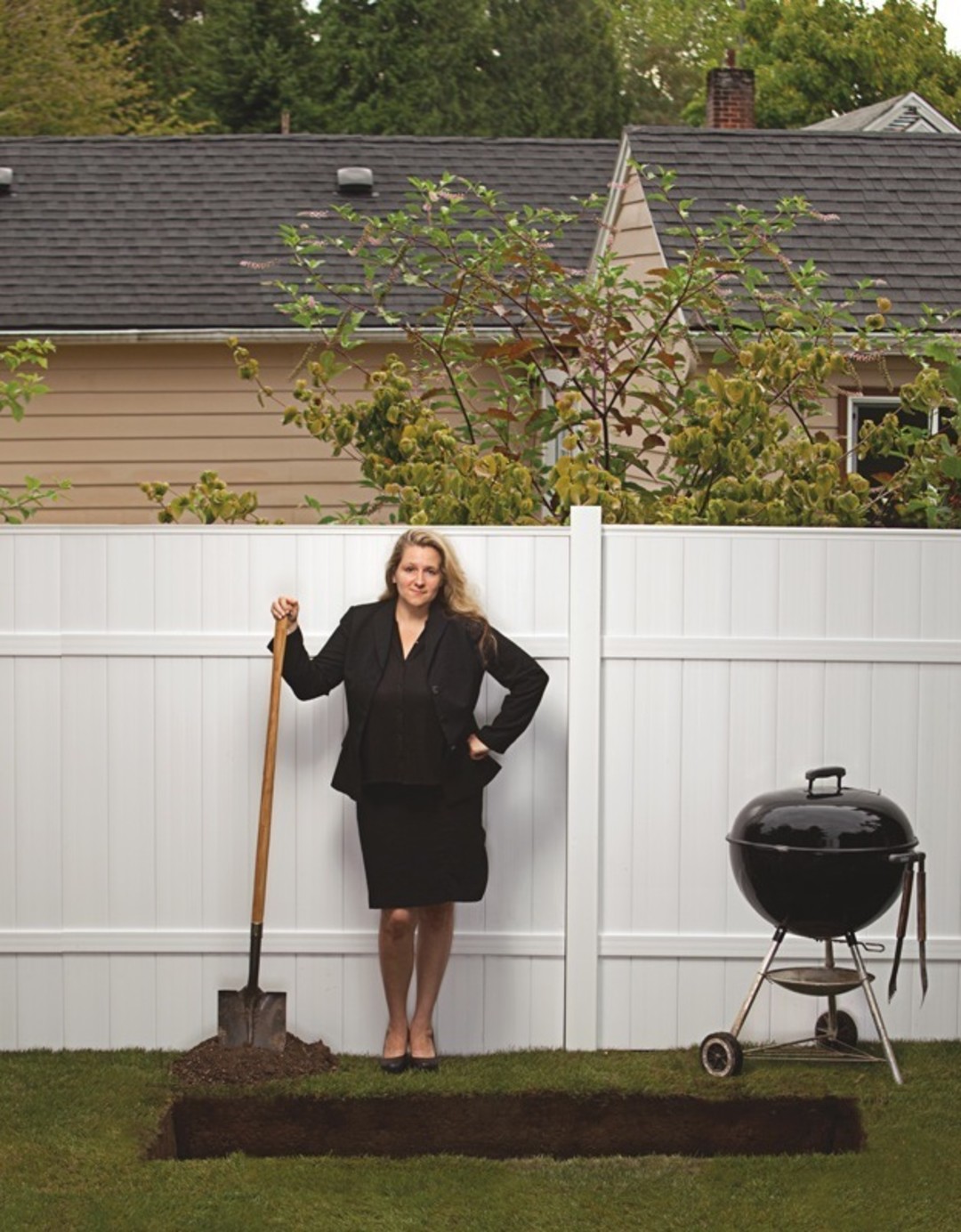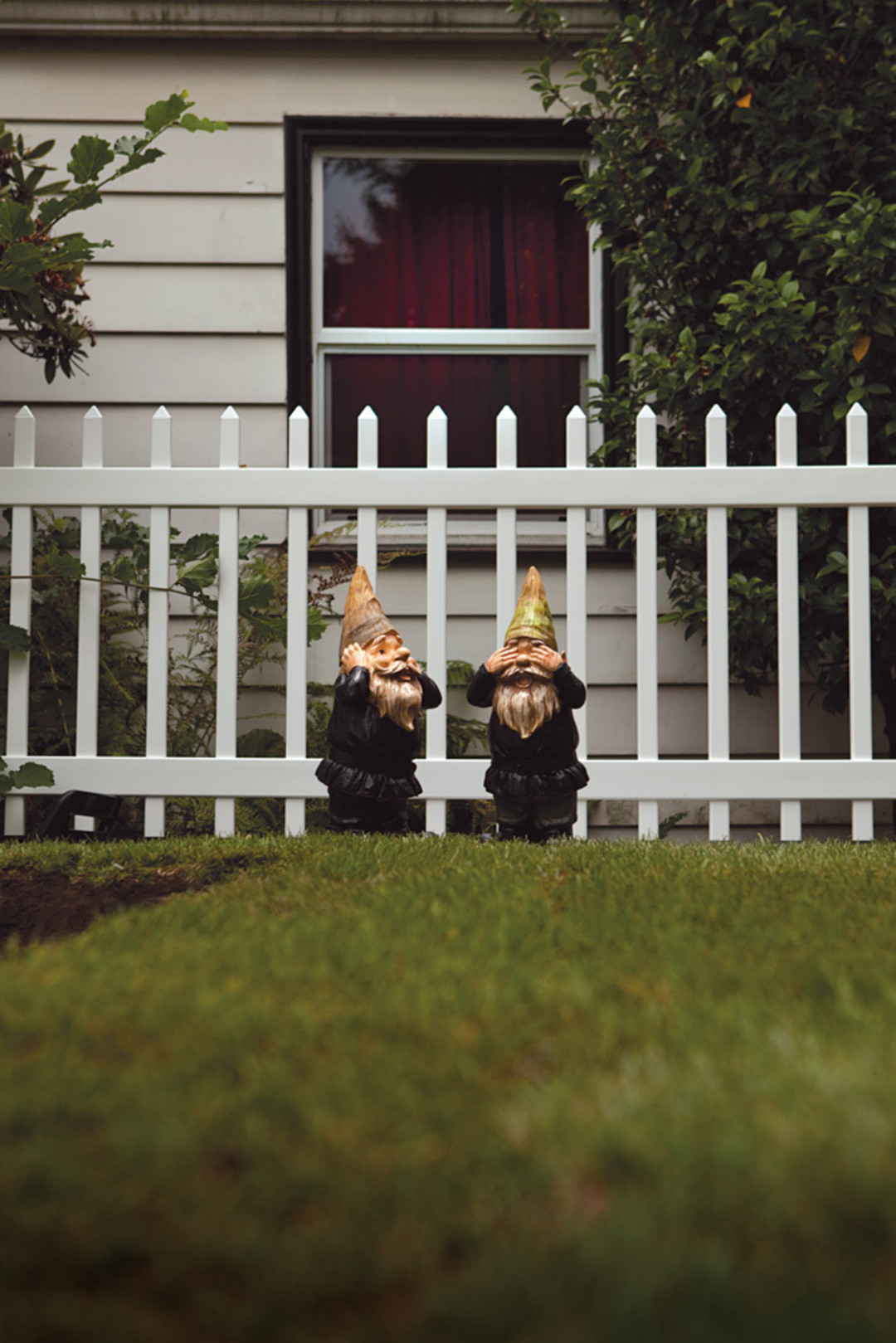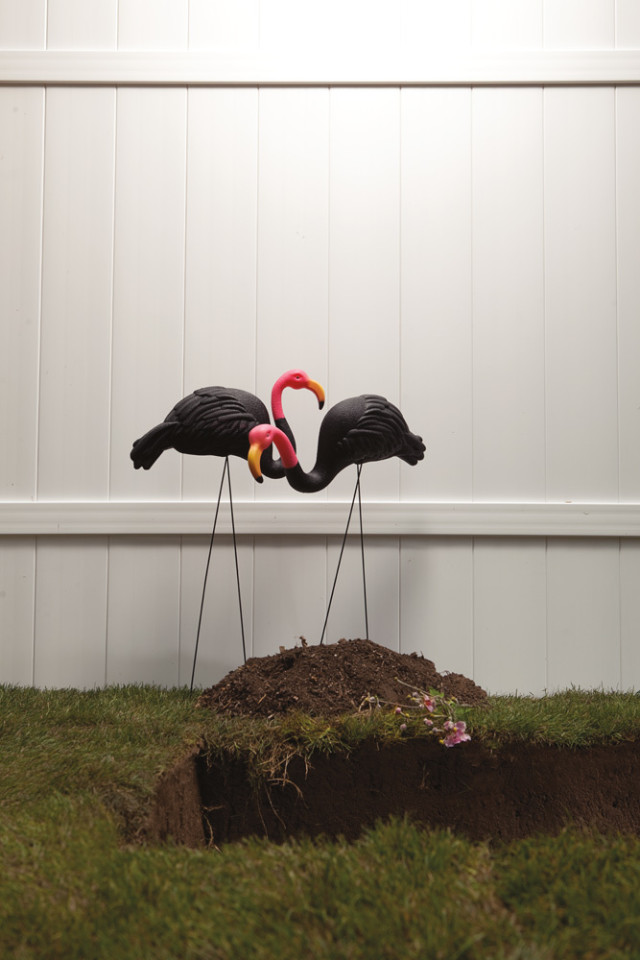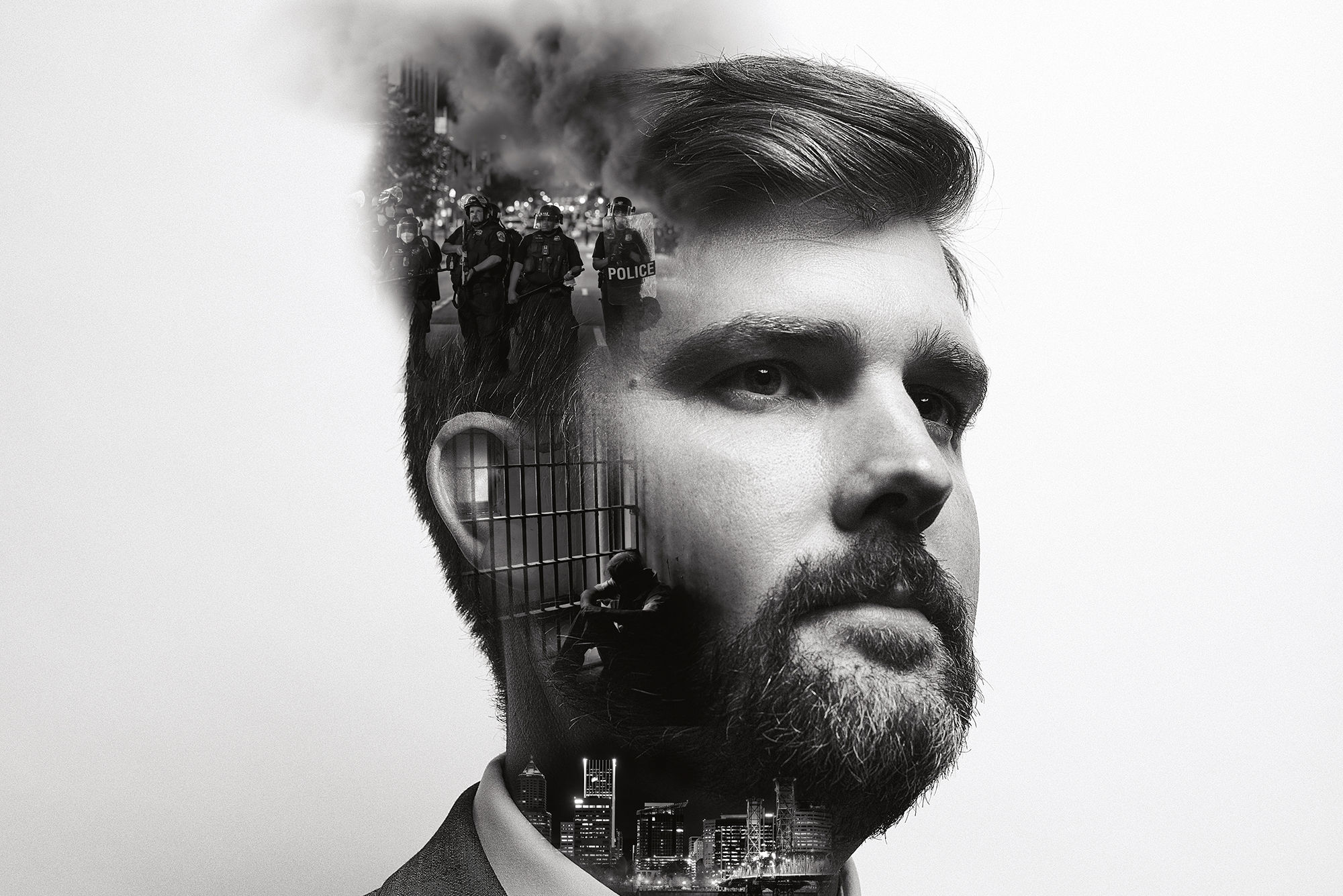Death Becomes Her

Image: William Anthony
Elizabeth Fournier was 8 years old when her mother died.
She found visiting with her body, at Young’s Funeral Home in Tigard, to be soothing.
“I felt OK there,” says Fournier, now 45. “I wanted to go back the next night of visitation to see her. I wasn’t scared. Something was nice about it.”
Life went on. Her father quickly remarried. Her last grandparent stepped in to help, then he died in turn. Meanwhile, Fournier nurtured that comfort she felt in the presence of the dead. In grade school, she walked cemeteries near her home in Beaverton.
“And then when I got to high school and could drive a car, I would do that Harold and Maude thing and go to people’s funerals I didn’t know,” says Fournier, sitting in the front room of Cornerstone, the funeral home she owns in Boring, Oregon. She started with funerals at Tigard’s St. Anthony, but soon branched out. Wearing a black dress and sitting in the last pew, Fournier would see how fragile the living were in the wake of death, how much they needed support. When she graduated from high school, she told her father she wanted to go to mortuary school.
“That’s not a good idea,” Fournier recalls her father saying. “You’re probably going to change your mind because you’re only 18 years old. Plus you’ll probably never get a date because it’s creepy!”
Her father was wrong about the dates. Fournier is married, with a 6-year-old daughter. She is also working in the funeral business, and working to change it.
The $15-billion-a-year death-care industry in America has bloated into a financially onerous, emotionally fraught, sometimes ethically problematic operation: pumping our dead full of toxic chemicals, selling us expensive caskets, and sending off our departed in unfamiliar rooms replete with organ music and fake marble. Fournier willingly offers services as grand and complex as families want. She also identifies with what is sometimes called the “alternative death” or “natural burial” movement, one shifting the responsibility of caring for the dead back to families, and in greener, cheaper, arguably more sensible directions. Taking care of our own, she believes, is good for both our wallets and our souls.
“People aren’t aware that when your loved one dies, you have options,” she says. “The first thing they’ll say at a hospital is, what mortuary are you going to use? And there’s that sense that, I guess I need to pick out a funeral home because someone needs to come and pick up this person...Now, people are realizing, ‘Hey! We can take this into our own hands.’ They can be present with it, and that aids your healing, a lot.”
Fournier’s father may have been wrong about her life’s path, but he was half-right about her changing her mind. She’s had many jobs, often with an emphasis on the theatrical. She worked as a ballroom dance teacher, played “Tough Looking Woman” on the TV series Grimm, and has done voiceover work for 25 years, ever since a radio DJ told her she had a great voice (which she does: all throat and honey, Brenda Vaccaro without the scratch). Still, the funeral business stayed on her mind. But what did it mean to be a mortician? She did not consider herself “a black suit kind of girl”; she was young and “kind of kooky.”
Between her junior and senior years at Linfield College, she took a job as the on-site caretaker at Sunset Hills Memorial Park in Southwest Portland. She thought it might be fun to live in a trailer in the middle of the cemetery. It was not.
“Scariest summer of my life,” she says, recalling being frightened not by the dead but by the living, who partied on the graves, peered into her trailer, and prank-called at midnight, saying, “I’m locked inside the cemetery and I need you to get me out!”
“I was 22 years old with long blond hair,” she says, with a shrug that suggests she might have expected to be seen as a curiosity. What Fournier did not expect was a different sort of contact.
“I would get someone calling in the middle of the night, saying, ‘My brother’s [interred] there; I need to know he’s OK,’” she says. “I’d spend an hour on the phone with this person. I realized I do have some of these skills. I can talk to these people. Maybe this is more than just being there with a big car at a funeral at a church and handing out folders. What it really is about is comforting these people.”
She honed the capacity for which she felt destined and became a licensed funeral director first in California, then in Oregon, before buying Cornerstone from its aging owner in 2005. If Fournier is the consoling professional bereaved families need, there is also the sense—as she mentions her appearance on Grimm or that she was once fired from a DJ gig for playing “You Light Up My Life” one too many times—that at any moment that big voice of hers might break into a show tune.

Image: William Anthony
Physically speaking, death is not creepy but routine. Life leaves the body quietly. The body will decompose, but not to the point where you need to worry about odor for a day or two, a period that can be stretched, for instance, by refrigerating the body or placing it on dry ice. Certainly, the person we knew ceasing to exist is frightening to some. But is it more frightening than entrusting your husband’s body to strangers, so that the next time you see him he is embalmed and wearing makeup? Still, it is understandable to want after-death care out of sight, to think it will hurt less if someone else deals with it.
This is where the traditional funeral industry steps in, offering to take the burden off your hands in your time of need, with embalming (not required by state law), metal caskets, burial vaults (to protect the buried casket from the weight of the earth), a hearse, and a motorcade. The average price as of 2009, not including a burial plot: $7,755.
There are two reasons for the elaborate send-off: to make money for the industry, and to make the living feel they have shown Mom, via pomp and product, how much they love her. Whether this makes anyone feel any better is up for debate. A growing number of people feel it does not. Some hire death-midwives, who stay with families during the dying process and help take care of the body, or choose “green cemeteries” with conservation easements that ensure the land will remain undeveloped. To some, a fancy send-off isn’t an expensive casket; it’s a rocket, shooting their cremains into space.
The funeral industry is well aware of the trends, toward cremation (less than 10 percent nationally in 1980, more than 40 percent today), for forgoing embalming (what, some might ask, are we preserving the body for?), for choosing rocks or trees as memorial markers. Profits in the industry have been in decline since 2007, as people choose to “celebrate a life” in more modest ways.
To stay competitive, funeral homes are not so much adding “green” choices as new bars to the same tune: memorial videos during a service have become commonplace; there’s the “interactive” Agean Healing Tree white marble vault cover, from which mourners can pluck a coin-shaped “memory ring” (“to attach to a keychain or simply keep in their pocket”).
Fournier also offers options, foremost among them an approach that recalls how we’ve mourned from time immemorial. She encourages clients to understand that they can wash and dress bodies for disposition (she will assist); bury bodies in wood boxes or other biodegradable containers (green burial); inter bodies or cremains on property they own; and act as their own funeral director. Her advocacy of natural burial has earned her the nickname “the Green Reaper,” a moniker she received during the Toshiba ad campaign “Boring vs. Normal,” a 2009 series of short-form videos wherein residents of the Oregon and Illinois towns competed for Internet celebrity.
The less-is-more approach is a good fit for Oregon, the first of the only three US states, so far, to pass legislation allowing physician-assisted suicide for some terminally ill patients, and where nearly 70 percent of those who died in 2011 were cremated. Oregonians want death their way. They also prefer to go gently instead of jamming the earth with embalming solvents (including formaldehyde, a known carcinogen) and caskets that incorporate as much metal and upholstery as a car.
“People find out the painful truth later, that it didn’t really help them,” says Fournier of the sometimes five-figure packages she once sold as an employee of several large funeral chains. “What I learned at corporations was it was about the merchandise, the upselling.” Comfort, she was told, was about providing the opportunity to grieve via ever more expensive packages of services. “It just felt horrible, especially when someone came in with a teenage son that died, and they couldn’t afford this! And they couldn’t bury him until they could pay every penny, and I thought, my God, if I ever had a place, I would do payment plans, I would give stuff away.”

Image: William Anthony
No one will mistake Cornerstone for a corporate funeral home. The building is a former goat barn. The only caskets on display are made of wicker and pine. And where one might expect a show of solemnity, there is a pencil portrait of Clint Eastwood over Fournier’s desk.
“If you’re expecting marble and stately columns, you probably wouldn’t be here,” says Fournier. “We are definitely in the hillbilly spectrum, and that is just fine.”
The hillbilly appellation is a stretch for Fournier, a self-described “city girl” who keeps her blond hair long, has enviable cheekbones, and flashes a little something of Meryl Streep in the trailer for Green Reaper, a reality show she pitched to a Los Angeles production company. In it, she and husband Michael Potts (a certified cremator) wrestle a tarp-wrapped corpse down a staircase. (“I’ve pitched it to multiple networks—they’re very favorable on it,” said producer Darryl Silver, reached in his car by Apalachicola Bay, where he was purusing a series about alligators in the Florida swamps.)
Fournier’s willingness to take center stage—in addition to her television and radio work she is the author of All Men Are Cremated Equal: My 77 Blind Dates, a memoir about her search for a husband while working as a mortician—might be seen as a love of the limelight. It might better be seen as a willingness to be a beacon in dark days. It helps to have a big personality around, letting people know things are going to be OK, that Fournier will take charge and ease your way.
Also easing: Cornerstone’s prices, which are reasonable, even altruistic. Services for children under age 8, for instance, are free. Paid packages start at $595 (for direct cremation, which Fournier outsources to a company in Northeast Portland). They top out at $1,850, for a burial-funeral package with no hidden costs.
“For green burial, I just charge $795,” she says. “I’m there with you when the passing happens, we wash, we bathe, we shroud, we do the ice, all the paperwork, we transport your loved one to the cemetery: $795.” (Fournier’s prices do not include the cost of the cemetery plot, which can add thousands of dollars even for green burial, which not all cemeteries accommodate.)
Fournier does, she says, occasionally need to rein in people’s DIY enthusiasms, to explain the difference between green burial and composting. “People say, just leave me at my house and then, we can go ahead and bring Mom out in the backyard. Yeah...but Mom probably doesn’t want to be carried out naked. Also, the person who’s putting dirt on her probably doesn’t want to see Mom’s face. So we have to walk people through all those steps.”
Delivering practical advice, working out logistics, keeps Fournier busy; she estimates she deals with 20 deaths a month, ranging from simple cremations to full funerals. While the low rent at Cornerstone allows Fournier to keep services affordable, her refusal to raise prices is a point of contention with her husband. (Potts is seen in the Green Reaper trailer throwing up his hands and telling his wife, “You might as well just give everything away!”) Fournier holds to her convictions. She talks with many people free of charge, people to whom she may not sell a thing but who need something to hang on to when the floor of their world has fallen out. This can be Fournier telling two young children whose mother has just died, “You will be OK, you will get through this—I was just where you were.” When Fournier’s daughter was an infant, services sometimes included simply allowing the grief-stricken to hold her.
“Her name is Sofia, after (the widowed) St. Sofia. That was purposeful,” says Fournier. “People would actually come and knock on the door and say, ‘Is your baby here?’ I would have her in my advertising. People would hold her, and it was such a comfort. It’s the circle of life and death.”
It’s 10 a.m. on a sunny Saturday, and Fournier is on the phone: a family had a death three days earlier, and they are unhappy with the funeral home they’re dealing with in Gresham. Can Fournier step in? She assures the family she can.
She does not tell them she is currently standing in the parking lot of Maranatha Church in Northeast Portland, where a “Homegoing Celebration” for Willie Vera Ranson is set to begin in an hour, with Fournier as the person family members look to for guidance: Is there another guest book? How can they prop up the poster of Grandma? And where, by the way, is Grandma?
Dressed in a latticed black blouse through which peeps a coral camisole, the color matching her toenail polish, Fournier assures Mrs. Ranson’s relatives that the hearse has just pulled up, that “absolutely” they can touch up their late grandmother’s hair, that Fournier will make sure extra programs are saved for the family.
“It’s always pandemonium just before the funeral starts,” she says. “Someone said to me recently, you’re like a wedding planner, but for dead people. I told her, yes, it’s very similar. You’re going to invite the same people, probably have the same music, the same food, the same flowers. The difference is, rather than having a year to plan it, I have four days.”
Fournier helps several elderly women in church hats to their seats, and then she steps outside to take another call, from someone who expects a loved one to die today.
“And how are you doing?” she asks the person. “All you need to do is get by in the moment—and drink some water.”
Two of Fournier’s assistants roll the casket before the altar. They raise the top half of the lid, showing the 87-year-old Mrs. Ranson in repose, in a nest of ivory satin.
“Whenever there is a ‘homegoing,’ there is a viewing beforehand,” says Fournier, of today’s arrangements. The casket is a rental. Mrs. Ranson will be cremated—a nontraditional but growing choice in the African American community, according to Fournier—so there was no reason to have the family purchase one.
The service begins at 11 on the dot. The pastor recites Psalm 23. Sister Willie Ranson is recalled as “altogether lovely.” The gospel singers sing. Emotions rise and converge in a way that brings tears to the throat—Fournier’s, too. She has once more transformed grief into memorial.
“It’s a very healing place,” she says, gazing at the altar.
Her phone vibrates again.




